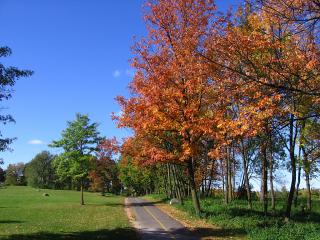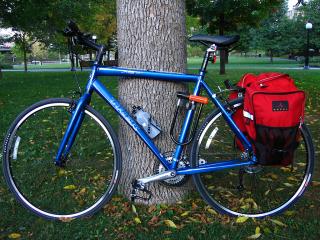Riding eastward across Ottawa from Booth Street towards Sandy Hill, it is far wiser to head north to the river and follow the riverside path than it is to push straight through Centretown. The most obvious reason for this is aesthetic, since the path offers a beautiful view of the river and Parliament Hill. A more technical reason has to do with traffic dynamics. As this paper on bicycle commuting explains:
Bicyclists can work only so hard. The average commuting rider is unlikely to produce more than 100 watts of propulsion power, or about what it takes to power a reading lamp. At 100 watts, the average cyclist can travel about 12.5 miles per hour on the level. When necessary, a serious cyclist can generate far more power than that (up to perhaps 500 watts for a racing cyclist, equivalent to the amount used by a stove burner on low). But even if a commuter cyclist could produce more than 100 watts, she is unlikely to do so because this would force her to sweat heavily, which is a problem for any cyclist without a place to shower at work.
With only 100 watts’ worth (compared to 100,000 watts generated by a 150-horsepower car engine), bicyclists must husband their power. Accelerating from stops is strenuous, particularly since most cyclists feel a compulsion to regain their former speed quickly. They also have to pedal hard to get the bike moving forward fast enough to avoid falling down while rapidly upshifting to get back up to speed.
For example, on a street with a stop sign every 300 feet, calculations predict that the average speed of a 150-pound rider putting out 100 watts of power will diminish by about forty percent. If the bicyclist wants to maintain her average speed of 12.5 mph while still coming to a complete stop at each sign, she has to increase her output power to almost 500 watts. This is well beyond the ability of all but the most fit cyclists.
In addition to stop sign frequently, terrain is also an important factor:
These problems are compounded at uphill intersections. Even grades too small to be noticed by car drivers and pedestrians slow cyclists substantially. For example, a rise of just three feet in a hundred will cut the speed of a 150-pound, 100-watt cyclist in half. The extra force required to attain a stable speed quickly on a grade after stopping at a stop sign is particularly grating.
This is especially true when there are drivers behind you freaking out because the time it takes you to accelerate will make them three seconds later in reaching the next red light or stop sign.
The whole article is worth a look. One fact most people will not know: Idaho allows cyclists to treat stop signs as yield signs, allowing them to cycle through at normal speed if no other vehicles are near the intersection.





